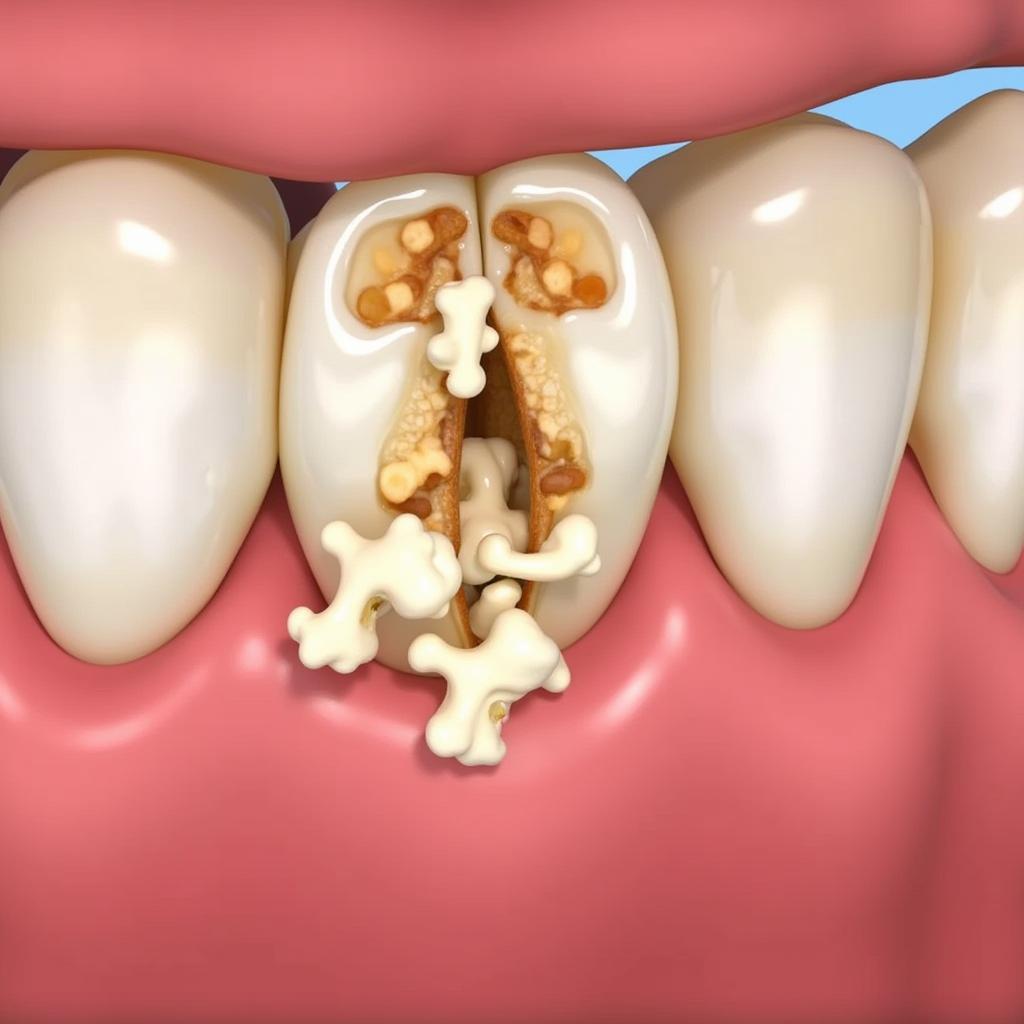We’ve all been there: enjoying a delicious meal only to be interrupted by the irritating feeling of food lodged between our teeth. While a minor annoyance for most, Food Stuck In Between Teeth Pain can quickly escalate from a niggle to a real pain, impacting your comfort and mood. So, what causes this dental dilemma, and more importantly, how can you find relief and prevent it from happening again?
Why Does Food Getting Stuck in My Teeth Hurt?
The pain associated with trapped food particles isn’t usually from the food itself, but rather the body’s reaction to it. When food gets wedged between teeth, it can irritate the gums and put pressure on the sensitive tissues. This pressure can lead to inflammation, soreness, and even throbbing pain. In some cases, trapped food can also contribute to gum disease, which further exacerbates pain and discomfort.
Common Culprits: Foods Most Likely to Get Stuck
Some foods are notorious for their ability to become lodged between teeth. These include:
- Fibrous Foods: Think spinach, kale, and stringy meats. These foods often have thin strands that can easily wedge themselves between teeth.
- Sticky Foods: Caramel, gummies, and chewy breads can cling to teeth and be difficult to dislodge.
- Small, Hard Foods: Popcorn kernels, seeds, and nuts can easily slip between teeth and cause discomfort.
 Food Particles Stuck Between Teeth
Food Particles Stuck Between Teeth
Effective Ways to Relieve the Pain
Finding yourself with a stubborn piece of food stuck between your teeth? Try these proven techniques for relief:
- Gentle Flossing: Using waxed floss, carefully guide it between the affected teeth using a gentle sawing motion. Avoid snapping the floss as it can irritate the gums.
- Water Flossing: An oral irrigator uses a pressurized stream of water to flush out debris. This can be particularly helpful for dislodging particles under bridges or around braces.
- Interdental Brushes: These small, cone-shaped brushes come in various sizes to clean between teeth and are particularly helpful for wider gaps.
- Warm Salt Water Rinse: Dissolve a teaspoon of salt in a glass of warm water and swish it around your mouth for 30 seconds to help reduce inflammation and soothe irritation.
Preventing Food From Getting Stuck: Tips for a Healthier Smile
The best way to avoid the pain of trapped food is to prevent it in the first place. Follow these simple steps for a healthier smile:
- Brush Thoroughly: Brush your teeth at least twice a day for two minutes, paying attention to all surfaces.
- Floss Daily: Make flossing a non-negotiable part of your oral hygiene routine to remove food debris and plaque.
- Choose Your Foods Wisely: While you don’t have to avoid your favorite foods altogether, being mindful of portion sizes and chewing carefully can make a difference.
- Regular Dental Check-ups: See your dentist every six months for professional cleanings and checkups. They can identify and address any potential issues early on, including teeth alignment problems that could be contributing to food impaction.
“Many people don’t realize that the alignment of their teeth can significantly impact food impaction,” says Dr. Emily Carter, a leading dentist specializing in preventative care. “If you’re prone to getting food stuck, it’s worth discussing potential solutions with your dentist.”
Food Stuck in Teeth Pain: When to See a Dentist
While most cases of food stuck in teeth are easily resolved at home, certain situations warrant a trip to the dentist. Seek professional attention if:
- Pain is Severe or Persistent: If the pain is intense or doesn’t subside after trying home remedies, it could signal a more serious issue.
- Signs of Infection: Watch out for redness, swelling, bleeding gums, or a bad taste in your mouth, as these could indicate an infection.
- You Can’t Dislodge the Food: If you’re unable to remove the trapped food yourself, it’s crucial to seek professional help to avoid further complications.
Conclusion
Food stuck in between teeth pain can put a damper on even the most enjoyable meal. By understanding the causes, employing effective remedies, and adopting preventative measures, you can minimize the chances of experiencing this common dental woe and enjoy a healthier, more comfortable smile.
Remember, maintaining good oral hygiene habits and seeking professional dental care when needed are essential for preventing and addressing any dental discomfort.
FAQs
Q: Can food stuck in teeth cause bad breath?
A: Yes, food particles trapped between teeth can decompose, leading to unpleasant breath.
Q: Is it bad to use a toothpick to remove food from my teeth?
A: While toothpicks can sometimes help, they should be used cautiously. Aggressive poking can injure gums and push food further down.
Q: Why do I get food stuck in the same spot every time?
A: This could be due to a gap between teeth, a poorly fitting filling, or other dental work. Consult with your dentist to determine the underlying cause.
If you are experiencing pain or discomfort from food stuck in your teeth, please don’t hesitate to reach out for help. You can contact us at Phone Number: 02437655121, Email: minacones@gmail.com or visit our address at 3PGH+8R9, ĐT70A, thôn Trung, Bắc Từ Liêm, Hà Nội, Việt Nam. We have a 24/7 customer support team ready to assist you. For more information about dental care and related topics, you can find helpful resources on our website, such as “worst food for dogs teeth” and “can food stuck in teeth cause pain” .